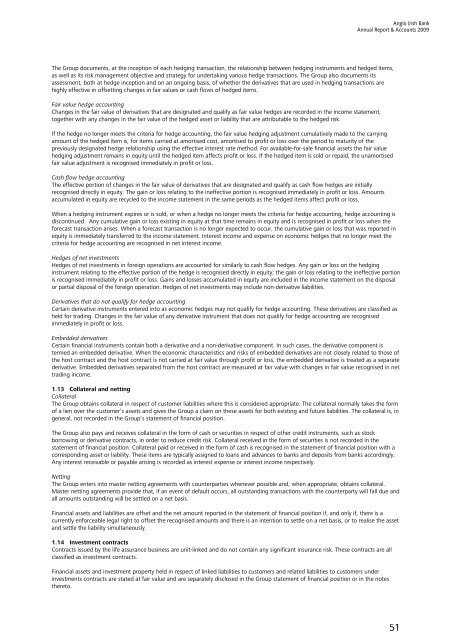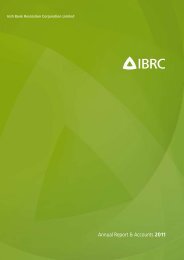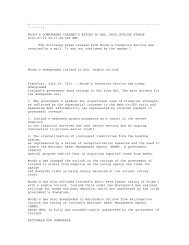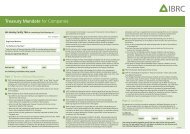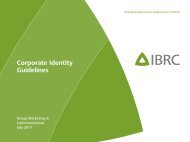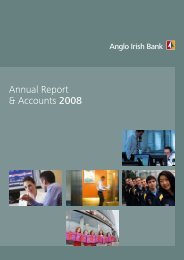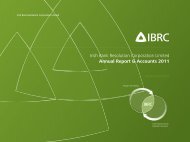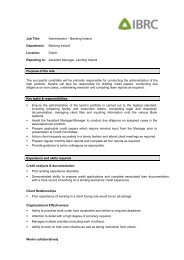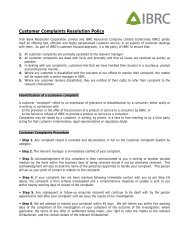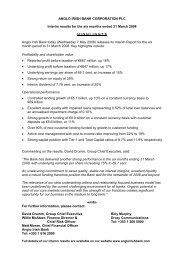Annual Report & Accounts 2009 - Anglo Irish Bank
Annual Report & Accounts 2009 - Anglo Irish Bank
Annual Report & Accounts 2009 - Anglo Irish Bank
Create successful ePaper yourself
Turn your PDF publications into a flip-book with our unique Google optimized e-Paper software.
The Group documents, at the inception of each hedging transaction, the relationship between hedging instruments and hedged items,<br />
as well as its risk management objective and strategy for undertaking various hedge transactions. The Group also documents its<br />
assessment, both at hedge inception and on an ongoing basis, of whether the derivatives that are used in hedging transactions are<br />
highly effective in offsetting changes in fair values or cash flows of hedged items.<br />
Fair value hedge accounting<br />
Changes in the fair value of derivatives that are designated and qualify as fair value hedges are recorded in the income statement,<br />
together with any changes in the fair value of the hedged asset or liability that are attributable to the hedged risk.<br />
If the hedge no longer meets the criteria for hedge accounting, the fair value hedging adjustment cumulatively made to the carrying<br />
amount of the hedged item is, for items carried at amortised cost, amortised to profit or loss over the period to maturity of the<br />
previously designated hedge relationship using the effective interest rate method. For available-for-sale financial assets the fair value<br />
hedging adjustment remains in equity until the hedged item affects profit or loss. If the hedged item is sold or repaid, the unamortised<br />
fair value adjustment is recognised immediately in profit or loss.<br />
Cash flow hedge accounting<br />
The effective portion of changes in the fair value of derivatives that are designated and qualify as cash flow hedges are initially<br />
recognised directly in equity. The gain or loss relating to the ineffective portion is recognised immediately in profit or loss. Amounts<br />
accumulated in equity are recycled to the income statement in the same periods as the hedged items affect profit or loss.<br />
When a hedging instrument expires or is sold, or when a hedge no longer meets the criteria for hedge accounting, hedge accounting is<br />
discontinued. Any cumulative gain or loss existing in equity at that time remains in equity and is recognised in profit or loss when the<br />
forecast transaction arises. When a forecast transaction is no longer expected to occur, the cumulative gain or loss that was reported in<br />
equity is immediately transferred to the income statement. Interest income and expense on economic hedges that no longer meet the<br />
criteria for hedge accounting are recognised in net interest income.<br />
Hedges of net investments<br />
Hedges of net investments in foreign operations are accounted for similarly to cash flow hedges. Any gain or loss on the hedging<br />
instrument relating to the effective portion of the hedge is recognised directly in equity; the gain or loss relating to the ineffective portion<br />
is recognised immediately in profit or loss. Gains and losses accumulated in equity are included in the income statement on the disposal<br />
or partial disposal of the foreign operation. Hedges of net investments may include non-derivative liabilities.<br />
Derivatives that do not qualify for hedge accounting<br />
Certain derivative instruments entered into as economic hedges may not qualify for hedge accounting. These derivatives are classified as<br />
held for trading. Changes in the fair value of any derivative instrument that does not qualify for hedge accounting are recognised<br />
immediately in profit or loss.<br />
Embedded derivatives<br />
Certain financial instruments contain both a derivative and a non-derivative component. In such cases, the derivative component is<br />
termed an embedded derivative. When the economic characteristics and risks of embedded derivatives are not closely related to those of<br />
the host contract and the host contract is not carried at fair value through profit or loss, the embedded derivative is treated as a separate<br />
derivative. Embedded derivatives separated from the host contract are measured at fair value with changes in fair value recognised in net<br />
trading income.<br />
1.13 Collateral and netting<br />
Collateral<br />
The Group obtains collateral in respect of customer liabilities where this is considered appropriate. The collateral normally takes the form<br />
of a lien over the customer’s assets and gives the Group a claim on these assets for both existing and future liabilities. The collateral is, in<br />
general, not recorded in the Group’s statement of financial position.<br />
The Group also pays and receives collateral in the form of cash or securities in respect of other credit instruments, such as stock<br />
borrowing or derivative contracts, in order to reduce credit risk. Collateral received in the form of securities is not recorded in the<br />
statement of financial position. Collateral paid or received in the form of cash is recognised in the statement of financial position with a<br />
corresponding asset or liability. These items are typically assigned to loans and advances to banks and deposits from banks accordingly.<br />
Any interest receivable or payable arising is recorded as interest expense or interest income respectively.<br />
Netting<br />
The Group enters into master netting agreements with counterparties whenever possible and, when appropriate, obtains collateral.<br />
Master netting agreements provide that, if an event of default occurs, all outstanding transactions with the counterparty will fall due and<br />
all amounts outstanding will be settled on a net basis.<br />
Financial assets and liabilities are offset and the net amount reported in the statement of financial position if, and only if, there is a<br />
currently enforceable legal right to offset the recognised amounts and there is an intention to settle on a net basis, or to realise the asset<br />
and settle the liability simultaneously.<br />
1.14 Investment contracts<br />
Contracts issued by the life assurance business are unit-linked and do not contain any significant insurance risk. These contracts are all<br />
classified as investment contracts.<br />
Financial assets and investment property held in respect of linked liabilities to customers and related liabilities to customers under<br />
investments contracts are stated at fair value and are separately disclosed in the Group statement of financial position or in the notes<br />
thereto.<br />
<strong>Anglo</strong> <strong>Irish</strong> <strong>Bank</strong><br />
<strong>Annual</strong> <strong>Report</strong> & <strong>Accounts</strong> <strong>2009</strong><br />
51


